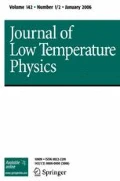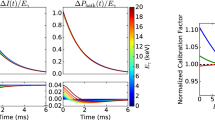Abstract
In this paper, we report on X-ray transition-edge sensor (TES) microcalorimeters optimized to have the best possible energy resolution for a limited energy range for the incoming X-rays, such as an energy resolution of 0.3 eV full width half maximum (FWHM) for energies up to \(\approx 0.8\,{\mathrm{keV}}\) as is desirable for one of the Lynx X-ray Microcalorimeter subarrays. The test array we have fabricated has \(60\times 60\) sensors on a pitch of \(50\,\upmu {\mathrm{m}}\), and has \(46\times 46\,\upmu {\mathrm{m}}^2\) absorbers that are one micrometer thick. We have measured a spectral energy resolution of the same device using 3 eV photons delivered through an optical fiber. For the one-photon 3 eV line, we have obtained an energy resolution of 0.25 eV FWHM, which is consistent with the estimated performance based on the signal size and noise. Further measurements will determine how the energy resolution degrades with energy. Based upon measurements of the TES transition characteristics, it appears that this level of energy resolution should be achievable up to 0.5 keV, and the performance will then gradually degrade to the measured energy resolution of around 2.3 eV at 1.5 keV. In this paper, we describe the full design and characterization of this detector, and discuss the performance limits of pixels designs like this.





Similar content being viewed by others
Notes
Manson model 2 mini-focus ultrasoft X-ray source made by Austin Instruments, Inc.
References
J.A. Gaskin et al., JATIS 5, 2 (2019). https://doi.org/10.1117/1.JATIS.5.2.021001
S.R. Bandler et al., JATIS 5, 2 (2019). https://doi.org/10.1117/1.JATIS.5.2.021017
N. Iyomoto et al., IEEE Trans. Appl. Supercon. 19, 557 (2009). https://doi.org/10.1109/TASC.2009.2017704
F.M. Finkbeiner et al., IEEE Trans. Appl. Supercon. 21, 223 (2011). https://doi.org/10.1109/TASC.2010.2091237
S.J. Smith et al., J. Appl. Phys. 114, 7 (2013). https://doi.org/10.1063/1.4818917
C.N. Bailey et al., J. Low Temp. Phys. 167, 121 (2012). https://doi.org/10.1007/s10909-012-0562-2
F.T. Jaeckel et al., IEEE Trans. Appl. Supercon. (2019). https://doi.org/10.1109/TASC.2019.2899856
N. Iyomoto et al., Appl. Phys. Lett. 92, 013508 (2008). https://doi.org/10.1063/1.2830665
K.D. Irwin, G.C. Hilton, Cryogenic Particle Detection, vol. 99 (Springer, Berlin, 2005)
Acknowledgements
Part of this work was performed under the auspices of the U.S. Department of Energy by Lawrence Livermore National Laboratory under Contract DE-AC52-07NA27344. The MIT Lincoln Laboratory portion of the work is based upon work supported by the United States Air Force under Air Force Contract No. FA8702-15-D-0001. Any opinions, findings, conclusions or recommendations expressed in this material are those of the author(s) and do not necessarily reflect the views of the United States Air Force.
Author information
Authors and Affiliations
Corresponding author
Additional information
Publisher's Note
Springer Nature remains neutral with regard to jurisdictional claims in published maps and institutional affiliations.
Rights and permissions
About this article
Cite this article
Sakai, K., Adams, J.S., Bandler, S.R. et al. Demonstration of Fine-Pitch High-Resolution X-ray Transition-Edge Sensor Microcalorimeters Optimized for Energies below 1 keV. J Low Temp Phys 199, 949–954 (2020). https://doi.org/10.1007/s10909-020-02409-2
Received:
Accepted:
Published:
Issue Date:
DOI: https://doi.org/10.1007/s10909-020-02409-2




